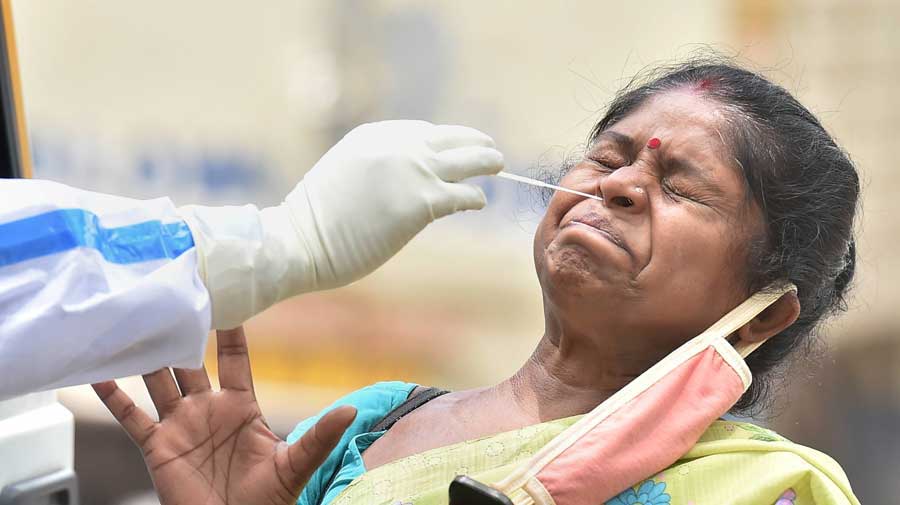
Bengal among states testing less: Centre- Bihar, Gujarat, Telangana and UP are also among states where check-up rates are below India’s average of 201 tests per day per million population
 G.S. Mudur | TT | New Delhi | 15.07.20 : Bengal is among 13 states or Union territories performing less than 140 coronavirus disease tests per day per million population, a threshold set by the World Health Organisation for “comprehensive” testing, according to data released by the Union health ministry on Tuesday.
G.S. Mudur | TT | New Delhi | 15.07.20 : Bengal is among 13 states or Union territories performing less than 140 coronavirus disease tests per day per million population, a threshold set by the World Health Organisation for “comprehensive” testing, according to data released by the Union health ministry on Tuesday.The health ministry said 22 states meet this numerical threshold for “comprehensive surveillance and testing of suspect cases”, releasing a list with Goa at the top with 1,058 tests per day per million population, followed by Delhi (978), Tripura (642), Tamil Nadu (563) and Jammu and Kashmir (540).
Bengal, Bihar, Gujarat, Telangana and Uttar Pradesh are among states where testing rates are below this threshold and less than India’s average of 201 tests per day per million population.
“The health ministry’s advice to states and (Union) territories has been to expand testing to meet this threshold set by the WHO,” said Rajesh Bhushan, officer-on-special duty in the ministry. “Increased testing will facilitate early detection and the treatment of cases.”
A WHO spokesperson told The Telegraph that the document Bhushan cited advises that countries should consider lifting public health and safety measures such as lockdowns if less than 5 per cent of samples are positive for Covid-19 for at least two weeks, assuming comprehensive surveillance put at one per 1,000 population per week. This, for India, translates into around 140 per million per day.
Although India has dramatically ramped up testing from less than 100 samples daily in early March to over 250,000 samples daily in July, health experts say significant differences in positivity — the number positive divided by the number tested — between states likely reflect testing patterns.
The positivity figures over the past week, for instance, vary from around 28 per cent in Telangana, 22 per cent in Maharashtra and 12 per cent in Delhi to 9 per cent in Gujarat, 7 per cent in Bengal and less than 4 per cent in Kerala or Uttar Pradesh.
Health experts say low positivity could be explained through wide, large-scale testing and localised outbreaks, while high positivity could mean either narrow testing — where only the most likely patients are tested — or a large epidemic where most people tested turn out positive.
“Increased testing is important — we cannot do without it,” said T. Sundararaman, a community medicine specialist and former director of the National Health Systems Resource Centre, a unit of the health ministry. “Only through testing and isolation can we break the chains of transmission.”
But Sundararaman and others argue that such broad state-level testing rates are unlikely to help formulate localised strategies to address the epidemic.
“We need district-level data to guide localised responses,” said Oommen John, a public health specialist with The George Institute for Global Health, New Delhi.
The health ministry had said earlier this month that 49 districts account for over 80 per cent of the country’s Covid-19 cases.
“We should ideally know testing rates within these districts and in the other districts too and how well are other districts prepared for comprehensive testing if the infection expands there,” John said.
Public health guidelines recommend a “test-track-treat” strategy that involves early testing to detect and isolate cases — either at home or in Covid-19 care centres — to prevent them from spreading their infection to others.
Community medicine experts concede that home isolation may not work in certain circumstances where asymptomatic persons may be compelled to work for economic reasons.
“There’s little we can do to avoid this, but even if a small fraction of those positive stay home or isolated, it could be better than them roaming about undetected,” John said.
Sundararaman said he would favour isolation in Covid-19 care centres as a general rule, with home isolation only in exceptional cases involving the elderly or children. “In some states such as Tamil Nadu, people have themselves opted for isolation in such Covid-19 care centres and not at home,” he said.
“What we really need to know is how many positive people are turning up from within quarantine and how many from outside quarantine — this is critical,” Sundararaman said. “If in a district, the vast majority of the positive cases detected are from within the set of quarantined people, then we can assume containment is working. If, on the other hand, the vast majority of cases are not from quarantine — it means trouble.”

0 Response to "Bengal among states testing less: Centre- Bihar, Gujarat, Telangana and UP are also among states where check-up rates are below India’s average of 201 tests per day per million population"
Post a Comment
Kalimpong News is a non-profit online News of Kalimpong Press Club managed by KalimNews.
Please be decent while commenting and register yourself with your email id.
Note: only a member of this blog may post a comment.